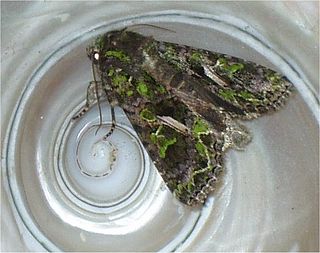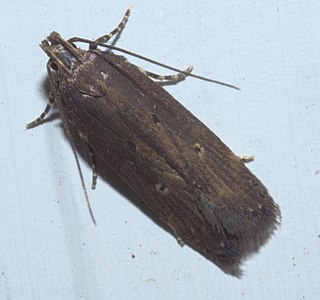
The angle shades is a moth of the family Noctuidae. The species was first described by Carl Linnaeus in his 1758 10th edition of Systema Naturae. It is distributed throughout Europe as far east as the Urals and also in the Azores, in Algeria, and in Asia Minor, Armenia, and Syria. It is strongly migratory.

Apamea crenata, known as the clouded-bordered brindle, is a moth in the family Noctuidae. It is distributed throughout the Palearctic realm. In the North it crosses the Arctic Circle, in the Mediterranean it is found only in cool locations and mountains avoiding very hot areas. In the Alps, it rises to an altitude of about 2000 metres.

Gangara thyrsis, commonly known as the giant redeye, is a species of butterfly belonging to the family Hesperiidae. It breeds on a number of palm species.

Appias lalage, the spot puffin, is a small butterfly of the family Pieridae, that is, the yellows and whites, which is found in India, Indochina and Hainan.

Appias indra, the plain puffin, is a small butterfly of the family Pieridae, that is, the yellows and whites, which is found in south and southeast Asia.

Mycalesis subdita, the Tamil bushbrown, is a satyrine butterfly found in south India and Sri Lanka. It is not resolved whether this is a good species or is a subspecies of Mycalesis visala.

Gangara lebadea, commonly known as the banded redeye, is a species of hesperid butterfly found in Southeast Asia.

Mythimna l-album, the L-album wainscot, is a moth of the family Noctuidae. The species was first described by Carl Linnaeus in his 1767 12th edition of Systema Naturae. It is distributed throughout Europe, but is also found in North Africa from Morocco to Tunisia and in the Levant, then east across the Palearctic to Central Asia. It is not found in the far north of the Arabian Peninsula. The limit in the north varies. It occurs on the northern edge of the range as a migrant. From southern England, then Denmark and southern Scandinavia, the north limit cuts across the Baltic Sea across the Baltic states then south of Moscow to the Urals.

Apamea lithoxylaea, the light arches, is a moth of the family Noctuidae. The species was first described by Michael Denis and Ignaz Schiffermüller in 1775. It is distributed throughout Europe, the Caucasus, Armenia, Asia Minor and Turkey, and ranges east to the Altai Mountains.

Apamea ophiogramma, the double lobed, is a moth of the family Noctuidae. It is found in the Palearctic realm in North and Central Europe to the Urals, Turkestan, Russian Far East, and Siberia. There have been at least two separate introductions into North America and it is now rapidly expanding in range. This species is sometimes placed in the monotypic genus Lateroligia.

Mormo maura, the old lady or black underwing, is a species of moth of the family Noctuidae. The species was first described by Carl Linnaeus in the 10th edition of his Systema Naturae. It is found in the Palearctic realm, from north-western Africa through all over southern Europe. It reaches its northern border in the west in northern Ireland and central Scotland, in central Europe, in northern Germany and Poland. In some Nordic countries, there are single finds. The other occurrence areas include Turkestan, Anatolia, the Middle East and Iraq. The name "old lady" refers to the fact that the wing pattern was said to resemble the shawls worn by elderly Victorian ladies.

Tiliacea citrago, the orange sallow, is a species of moth of the family Noctuidae. It is found in Europe as far east as the Caucasus Mountains and the Urals.

The Orache Moth(Trachea atriplicis) is a species of moth of the family Noctuidae. It is found in all of Europe, east across the Palearctic to the Pacific Ocean and Japan.

Helotropha leucostigma, the crescent, formerly Celaena leucostigma is a moth of the family Noctuidae. It is found in the Palearctic realm.

Mesapamea secalis, the common rustic, is a moth of the family Noctuidae. The species was first described by Carl Linnaeus in his 1758 10th edition of Systema Naturae. It is found in Europe, north-west Africa, Turkey and northern Iran.

Grammodes stolida, the geometrician, is a moth of the family Erebidae. The species was first described by Johan Christian Fabricius in 1775. It is found in Africa, southern Europe, most of Asia and Australia. It migrates to central and northern Europe as far north as England, Denmark and Finland.
Habrona marmorata is a moth in the family Drepanidae. It is widely distributed in Papua and Papua New Guinea.
Chionodes arenella is a moth in the family Gelechiidae. It is found in North America, where it has been recorded from Nova Scotia to Virginia.

Chionodes discoocellella, the eyeringed chionodes moth, is a moth in the family Gelechiidae. It is found in the United States, where it has been recorded from Maine to South Dakota, Florida, Texas and Colorado.
Chionodes helicosticta is a moth in the family Gelechiidae. It is found in North America, where it has been recorded from Texas, Arizona, California and Oregon.
















